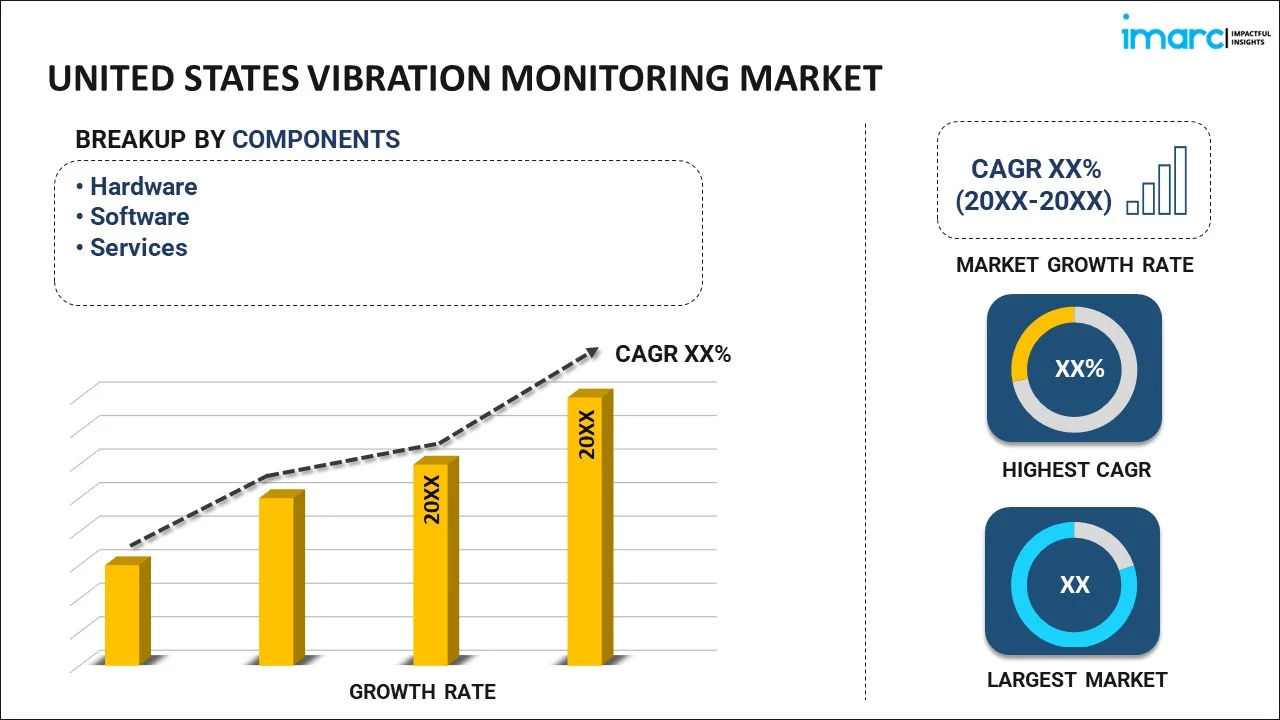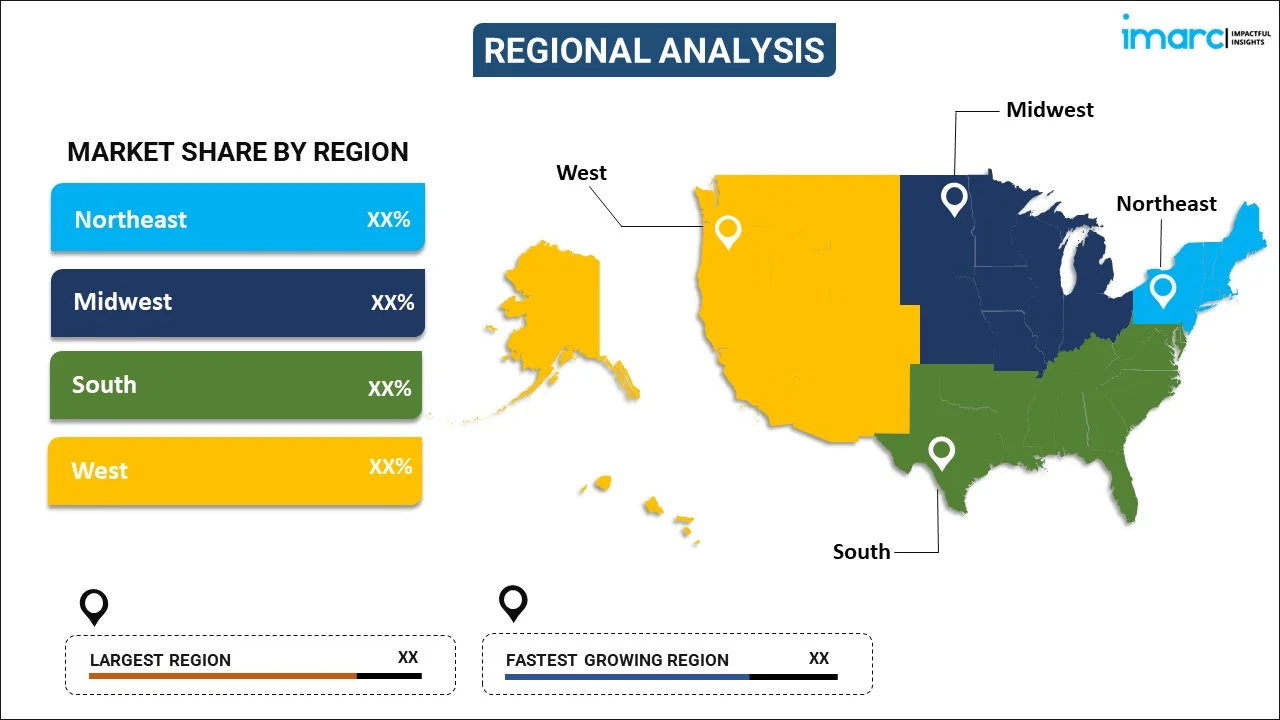
United States Vibration Monitoring Market Report by Component (Hardware, Software, Services), System Type (Embedded Systems, Vibration Analyzers, Vibration Meters), Monitoring Process (Online, Portable), End Use Industry (Energy and Power, Metals and Mining, Oil and Gas, Automotive, Food and Beverages, and Others), and Region 2024-2032
Market Overview:
United States vibration monitoring market size is projected to exhibit a growth rate (CAGR) of 6.17% during 2024-2032. The expanding industrial sectors such as manufacturing, oil and gas, power generation, and automotive, coupled with the rising demand for vibration monitoring systems to ensure the health and reliability of machinery, is driving the market.
|
Report Attribute
|
Key Statistics
|
|---|---|
|
Base Year
|
2023 |
|
Forecast Years
|
2024-2032
|
|
Historical Years
|
2018-2023
|
| Market Growth Rate (2024-2032) | 6.17% |
Vibration monitoring is a technique employed to assess and analyze the oscillations and movements within machinery or structures. It involves the use of sensors to detect vibrations, which can indicate potential issues such as misalignments, imbalances, or mechanical wear. By continuously monitoring these vibrations, engineers can identify abnormalities and predict potential failures before they occur. This proactive approach helps in minimizing downtime, preventing costly equipment damage, and enhancing overall operational efficiency. Vibration monitoring is widely utilized in various industries, including manufacturing, energy, and transportation, where the precise functioning of machinery is critical. Continuous analysis of vibration data enables timely maintenance interventions, ensuring the longevity and reliability of equipment while optimizing performance and safety.
United States Vibration Monitoring Market Trends:
The vibration monitoring market in the United States is experiencing robust growth driven by several key factors. Firstly, the increasing emphasis on predictive maintenance across various industries propels the demand for advanced monitoring solutions. As industries strive to enhance operational efficiency and minimize downtime, the adoption of vibration monitoring systems becomes crucial. Additionally, the rising awareness about the potential benefits of early fault detection and prevention fuels market expansion. Consequently, industries such as manufacturing, automotive, and aerospace are investing significantly in vibration monitoring technologies to safeguard critical machinery and optimize production processes. Moreover, the advent of Industry 4.0 and the integration of IoT (Internet of Things) in industrial operations contribute to the market's momentum. The ability of vibration monitoring systems to provide real-time data and facilitate remote monitoring aligns with the evolving smart manufacturing landscape. Furthermore, stringent regulations and safety standards across industries mandate the implementation of effective condition monitoring solutions, further boosting the market. In conclusion, the convergence of predictive maintenance strategies, technological advancements, and regulatory imperatives collectively propels the growth of the vibration monitoring market in the United States, positioning it as a pivotal element in contemporary industrial practices.
United States Vibration Monitoring Market Segmentation:
IMARC Group provides an analysis of the key trends in each segment of the market, along with forecasts at the country level for 2024-2032. Our report has categorized the market based on component, system type, monitoring process, and end use industry.
Component Insights:

- Hardware
- Software
- Services
The report has provided a detailed breakup and analysis of the market based on the component. This includes hardware, software, and services.
System Type Insights:
- Embedded Systems
- Vibration Analyzers
- Vibration Meters
A detailed breakup and analysis of the market based on the system type have also been provided in the report. This includes embedded systems, vibration analyzers, and vibration meters.
Monitoring Process Insights:
- Online
- Portable
The report has provided a detailed breakup and analysis of the market based on the monitoring process. This includes online and portable.
End Use Industry Insights:
- Energy and Power
- Metals and Mining
- Oil and Gas
- Automotive
- Food and Beverages
- Others
A detailed breakup and analysis of the market based on the end use industry have also been provided in the report. This includes energy and power, metals and mining, oil and gas, automotive, food and beverages, and others.
Regional Insights:

- Northeast
- Midwest
- South
- West
The report has also provided a comprehensive analysis of all the major regional markets, which include Northeast, Midwest, South, and West.
Competitive Landscape:
The market research report has also provided a comprehensive analysis of the competitive landscape in the market. Competitive analysis such as market structure, key player positioning, top winning strategies, competitive dashboard, and company evaluation quadrant has been covered in the report. Also, detailed profiles of all major companies have been provided.
United States Vibration Monitoring Market Report Coverage:
| Report Features | Details |
|---|---|
| Base Year of the Analysis | 2023 |
| Historical Period | 2018-2023 |
| Forecast Period | 2024-2032 |
| Units | US$ Million |
| Scope of the Report | Exploration of Historical and Forecast Trends, Industry Catalysts and Challenges, Segment-Wise Historical and Predictive Market Assessment:
|
| Components Covered | Hardware, Software, Services |
| System Types Covered | Embedded Systems, Vibration Analyzers, Vibration Meters |
| Monitoring Processes Covered | Online, Portable |
| End Use Industries Covered | Energy and Power, Metals and Mining, Oil and Gas, Automotive, Food and Beverages, Others |
| Regions Covered | Northeast, Midwest, South, West |
| Customization Scope | 10% Free Customization |
| Report Price and Purchase Option | Single User License: US$ 3699 Five User License: US$ 4699 Corporate License: US$ 5699 |
| Post-Sale Analyst Support | 10-12 Weeks |
| Delivery Format | PDF and Excel through Email (We can also provide the editable version of the report in PPT/Word format on special request) |
Key Questions Answered in This Report:
- How has the United States vibration monitoring market performed so far and how will it perform in the coming years?
- What has been the impact of COVID-19 on the United States vibration monitoring market?
- What is the breakup of the United States vibration monitoring market on the basis of component?
- What is the breakup of the United States vibration monitoring market on the basis of system type?
- What is the breakup of the United States vibration monitoring market on the basis of monitoring process?
- What is the breakup of the United States vibration monitoring market on the basis of end use industry?
- What are the various stages in the value chain of the United States vibration monitoring market?
- What are the key driving factors and challenges in the United States vibration monitoring?
- What is the structure of the United States vibration monitoring market and who are the key players?
- What is the degree of competition in the United States vibration monitoring market?
Key Benefits for Stakeholders:
- IMARC’s industry report offers a comprehensive quantitative analysis of various market segments, historical and current market trends, market forecasts, and dynamics of the United States vibration monitoring market from 2018-2032.
- The research report provides the latest information on the market drivers, challenges, and opportunities in the United States vibration monitoring market.
- Porter's five forces analysis assist stakeholders in assessing the impact of new entrants, competitive rivalry, supplier power, buyer power, and the threat of substitution. It helps stakeholders to analyze the level of competition within the United States vibration monitoring industry and its attractiveness.
- Competitive landscape allows stakeholders to understand their competitive environment and provides an insight into the current positions of key players in the market.
Need more help?
- Speak to our experienced analysts for insights on the current market scenarios.
- Include additional segments and countries to customize the report as per your requirement.
- Gain an unparalleled competitive advantage in your domain by understanding how to utilize the report and positively impacting your operations and revenue.
- For further assistance, please connect with our analysts.
 Inquire Before Buying
Inquire Before Buying
 Speak to an Analyst
Speak to an Analyst
 Request Brochure
Request Brochure
 Request Customization
Request Customization




.webp)




.webp)












